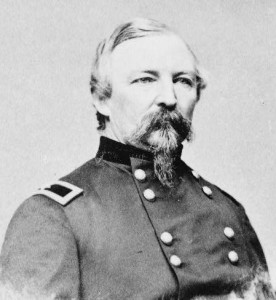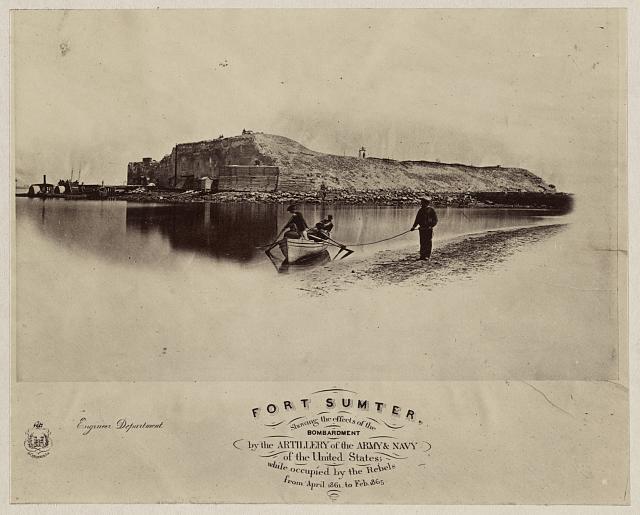It’s been over four years now since JASPER, The New-York Times’ correspondent wrote from Charleston in the seceded South Carolina. After the United States’ surrender of Fort Sumter in April 1861 JASPER was made to leave town. Now that Charleston was back in Union hands The Times had another correspondent in Charleston (who apparently didn’t sign himself with a pen name all in capitals). 150 years ago this month he reported that commerce was gradually increasing. Blacks organized a May 1st commemoration of the Union prisoners who died at a prison camp set up on the grounds of the Washington Race Track. The military commander of the city set up a home guard made up of black troops and also ordered blacks from the country back to the country to the plantations set aside for them by General Sherman.
From The New-York Times May 14, 1865:
OUR CHARLESTON CORRESPONDENCE.; Trade With the South The Railroads Mr. Lincoln’s Death Miscellaneous. TRADE WITH THE SOUTHERN STATES. THE RAILROAD LINES. THE PUBLIC SORROW. THE UNION DEAD. MAY-DAY FESTIVITIES. FROM THE INTERIOR. IMPORTANT ORDERS. …
CHARLESTON, Sunday, May 7, 1865.
The recent order of President JOHNSON, removing restrictions on commercial intercourse with the Southern States, has had a most encouraging effect on the business class of this community. The old residents, who have all along declined embarking in trade in consequence of the difficulties which existed in respect to getting a supply of goods to this market, now show symptoms of going ahead and establishing themselves in business. The stores on Meeting, King, and other streets are being repaired and refitted, and the prospect is highly flattering that, by next Fall, the City of Charleston will present an appearance of activity that has not attached to it since the commencement of the rebellion. The impression seems to have prevailed at the North that Charleston was nothing but a mass of ruins, and that, consequently, no business of moment could be transacted. Perhaps it will astonish some of our friends at a distance to know that already quite a number of wholesale houses are in full tide of operation. As soon as the arrangement can be effected, it is contemplated running a line of steamers between this port and New-York, thus opening a direct and easy communication between the two points. When it is explained that at present we are almost wholly dependent on the government steamers for Northern news, those steamers usually arriving not oftener than once a week, it will be readily perceived what a great benefit it will be to us, when facilities are offered for getting the news twice or thrice a week. Hundreds of persons residing here, or in other portions of the department, are extremely anxious to proceed North, but the means of transportation are so limited that comparatively few of the applicants succeed in getting permits on the regular steamers. The number of travelers will, of course, be augmented to no small extent when the railroad communications are opened with the interior, and, aside from the necessity of the undertaking, a line of steamers to New-York will yield a handsome profit to its owners.
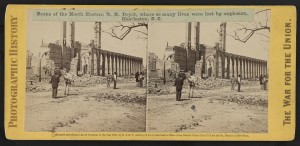
“Ruins of the North Eastern R. R. Depot, where so many lives were lost by explosion, Charleston, S.C.” (c1865, Library of Congress)
Measures are on foot to place the South Carolina, the Northeastern and other railroad lines dive[???]ing from the city, in running order. We will probably have the cars in motion in the direction of Columbia in three weeks’ time. An immense quantity of cotton is represented to be hidden away in the small towns which will find its way to this market and be used in exchange for Northern goods. In the absence of suitable stock and material it will be some months before the railroad will extend to the public the accommodations which they did formerly, but, doubtless all these matters will be adjusted as soon as orders can be filled at the Northern workshops. It would be a great convenience to have the Savannah railroad speedily opened, for the reason that the business relations of the two cities are such as require daily intercourse between them. The farmers and producers in the country are preparing to send supplies to this city when the communications will warrant the movement. For a while we must depend on the North for provisions, or until the crops can be raised in our own section.
In accordance with official orders, Tuesday of last week, was observed throughout the district as a day of humiliation, fasting and prayer. The national flag, draped and festooned with black, was displayed on public and private buildings, and from the vessels in the harbor. Business was generally suspended. Services were held in nearly all the churches, and a deep sense of the painful loss the country has sustained in the death of its Chief Magistrate pervaded the entire community. At sunrise a salute of thirteen guns was fired from the forts at the citadel and the arsenal. During the day guns were fired at intervals of half an hour, and at sunset a salute of thirty-six guns closed the ceremonies.
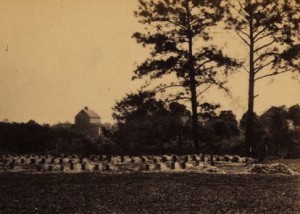
“A series of tombstones was installed at Washington Race Course in Charleston, South Carolina, marking the burial places of over one hundred Union soldiers.”
On the 1st of May the solemn ceremonies of dedicating the grounds of the Race Course where are buried two hundred and fifty-seven Union soldiers, who were prisoners in rebel hands, and who died from cruel treatment, were performed by the colored portion of this community. It is estimated that nearly ten thousand people were on the ground. The military organizations present were the Fifty-fourth New-York Volunteers, and the Thirty-fifth and One Hundred and Fourth colored regiments. Among the speakers were Gen. HARTWELL, Col. BEECHER, Rev. Mr. LOWE, and a number of leading colored men. Previous to the ceremonies, on the 1st, a party of twenty-five colored men belonging to an association known as “Friends of the Martyrs,” repaired to the grounds and newly raised the graves and erected a neat fence around the inclosure. A number of the “Patriotic Association of Colored Men” assisted in the work. In the course of the afternoon a procession was formed, in the line of which were nearly three thousand school-children. As they passed round the graves these children scattered upon them bouquets of flowers, as did also the others in the procession. The children then joined in singing a number of national and patriotic airs, after which the speaking was commenced. The only event which marred the solemnity of the occasion was the presence of a pic-nic party (colored) at a short distance from the Race Course.
The 1st of May was joyously celebrated in Charleston by about one thousand white children, accompanied by their school teachers. At an early hour in the morning the party embarked on board the steamer Gen. Hooker and paid a visit to Fort Sumter and other fortifications in the harbor. In the afternoon the steamer made a trip up to Cooper and Ashley Rivers, and then came back to the city. In this instance, it will be observed, that the white portion of the people here have received some share of public attention, although at times it has really seemed as if there were no other than the colored population to be considered. If matters, relating to the condition and position of the colored people in this section be not perceptibly modified, we should not be surprised to learn of a change of sentiment among that class of whites who have always looked upon the subject in a consistent and practical light. If the individuals who look after the interests of the colored people will carry out the views of the government, they will do all that is required of them.
The disbanded officers and soldiers of LEE’s and JOHNSTON’s armies are finding their way to their several homes. A large number of the men of JOHNSTON’s force are among the recent arrivals in town. Yesterday and to-day quite a large party of WHEELER’s and JENKINS’ cavalry troops has made their way thither. In accordance with instructions from their commanding officers, they left their arms at Greensboro, where they will be taken possession of by the United States authorities. They know nothing of the whereabouts of DAVIS. Gov. MAGRATH has been at Greenville, using his fluence to get the South Carolina Legislature together’ with a view of appointing Senators and Representatives to the National Congress. The statement is fully corroborated that a large portion of JOHNSTON’s army were disbanded before the terms of surrender were effected with Gen. GRANT. Rebel money is utterly worthless; the people refuse to have anything to do with it. They are all rejoicing at the prospect of again enjoying a peace, and clamor loudly for Union.
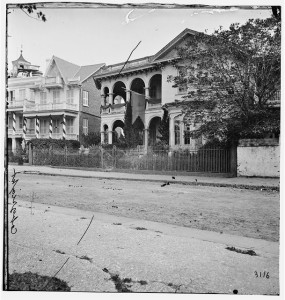
“Charleston, South Carolina. Headquarters of Gen. John P. Hatch, South Battery” (April or May 1865, Library of Congress)
General orders lately issued by Gen. HATCH, authorizes the formation of a Home Guard for the defence of the city when the troops now stationed here shall be sent on service elsewhere. The guard is made up of colored people. Yesterday a company of sixty of the guard paraded on Meeting-street, and attracted no small degree of attention by their neat and uniform appearance and their regularity in marching. They are to be assigned an armory somewhere near the citadel. In the same order, the colored people coming from the country are given ten days to leave the city and settle themselves upon the plantations set apart for their use by Gen. SHERMAN. Should they fail to comply with the orders they are informed that they can draw no more rations from the government. This is a step in the right direction. It is quite time that the city was rid of the thousands of idle and dissolute fellows who have no inclination to help themselves so long as government gives them free support. …
You can read part of an article about the May 1st ceremony at the race course by David W. Blight at Wikipedia. The Preservation Society of CharlestonPreservation Society of Charleston supports the idea that the Charleston commemoration was the nation’s first Memorial Day:
During the Civil War, Washington Race Course became a camp for Union prisoners of war. The death rate in the open field was frightful – at least 257 men died, and were buried in unmarked graves. After Union forces occupied Charleston, the dead were exhumed and reburied under respectful markers. In April 1865, freedmen built a fence around the burial ground, with an arch reading “Martyrs of the Race Course.” On May 1, 1865, thousands of African-Americans – freed slaves, children, Union soldiers – made a procession to the cemetery. They laid flowers on the graves, listened to speakers of both races, and picnicked on the grass. This celebration was America’s first Memorial Day. The martyrs of the racecourse were exhumed again in 1871 for proper military burial in South Carolina’s national cemeteries at Beaufort and Florence.

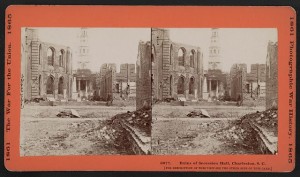
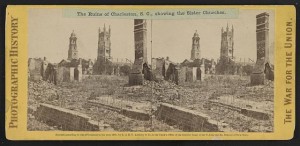
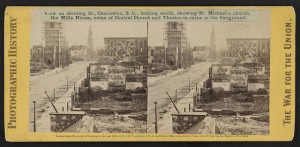
![Interior views of Fort Sumter, in April, 1865 (photographed 1865, [printed between 1880 and 1889]; LOC: http://www.loc.gov/item/2014646431/)](https://www.bluegrayreview.com/wp-content/uploads/2015/05/35199v-287x300.jpg)
